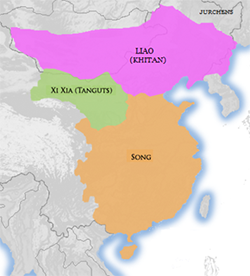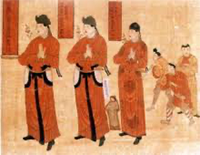China's Western Xia Dynasty
The Western Xia Dynasty ruled over a part of what is now northwestern China for nearly two centuries in early medieval times. 
People known as the Tanguts made up much of the land claimed and ruled by the Western Xia. (They called their empire Minyak.) Through their land ran the famous Silk Road, the long trade route running from East to West. Tangut people were allies of the Sui Dynasty in the 7th Century and friends of the Tang Dynasty later on. That friendship became more of a tributary relationship, and Tangut leaders eventually revolted, clashing with one of China's 10th Century Five Dynasties, the Later Tang, and aiding another, the Later Jin, the latter alliance helping to form the Liao Empire. It was in the 11th Century that the Western Xia Empire arrived. By that time, Tangut leaders had a tributary relationship with both the Liao and the Song. In a show of strength, the Tangut leader Yuanhao declared himself emperor. The Western Xia, with its capital at Xingqing, began in 1038. A series of escalating disagreements between Song and Western Xia resulted in a war between the two peoples. Western Xia forces got the better of Song forces more often than not, but a Song alliance with the Jin resulted in a defeat of the Western Xia, in 1044. The losers agreed to pay a large tribute to their Song victors but didn't end up losing much territory. Yuanhao died four years later, and his very young son Liangzuo succeeded him. 
When the new emperor was 16, he began a series of raids into Song territory; the raids carried on for a few years. A Song counterattack resulted in the blunting of Liangzuo's gains and a mortal wound to the emperor himself. Subsequent emperors endorsed similar tactics, and the Song-Western Xia struggle ground on, continuing on and off for the next several decades. Western Xia leaders turned to face a different foe in 1205, as the first Mongol invasion began. Mongol armies found increasing success within the Western Xia realm, and the traditional Tanguts reached out in desperation to the Jin Empire for an alliance. By that time, however, the Mongols, led by the great Genghis Khan, had targeted the Jin as well. Western Xia forces fought on, finally succumbing to the Mongol wave in 1227. Little of Western Xia remains. The Tanguts had their own language, spoken and written. Some wealthy Tanguts escaped to Tibet, taking their culture and their memories with them. The Mongols, however, were more or less successful at eradicating this foe. |
|




